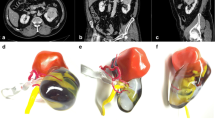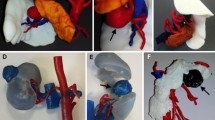Abstract
Background
Thyroid glands and surrounding structures are very complex, and this complexity can pose a challenge for clinicians when explaining and communicating to the patient the details of a proposed surgery for thyroid cancer. A three-dimensional (3D) thyroid cancer model could help and improve this communication.
Methods
A 3D-printed phantom of a thyroid gland and its presenting cancer was produced from segmented head and neck contrast-enhanced computed tomography (CT) data from a patient with thyroid cancer. The phantom reflects the complex anatomy of the arteries, veins, nerves, and other surrounding organs, and the printing materials and techniques were adjusted to represent the texture and color of the actual structures. Using this phantom, patients and clinicians completed surveys on the usefulness of this 3D-printed thyroid cancer phantom. Participants: patients (n = 33) and clinicians (n = 10).
Results
In the patient survey, the patients communicated that the quality of understanding of their thyroid disease status was enhanced when clinicians explained using the phantom. The clinicians communicated that the 3D phantom was advantageous for explaining complex thyroid surgery procedures to patients, and that the 3D phantom was helpful in educating patients with relatively poor anatomical knowledge.
Conclusions
Using 3D printing technology, we produced a CT-based 3D thyroid cancer phantom, and patient and clinician surveys on its utility indicated that it successfully helped educate patients, providing them with an improved understanding of the disease.



Similar content being viewed by others
References
Durante C, Montesano T, Torlontano M et al (2013) Papillary thyroid cancer: time course of recurrences during postsurgery surveillance. J Clin Endocrinol Metab 98:636–642
Cho BY, Choi HS, Park YJ et al (2013) Changes in the clinicopathological characteristics and outcomes of thyroid cancer in Korea over the past four decades. Thyroid 23:797–804
Sampson E, Brierley JD, Le LW et al (2007) Clinical management and outcome of papillary and follicular (differentiated) thyroid cancer presenting with distant metastasis at diagnosis. Cancer 110:1451–1456
Kim H, Kim HI, Kim SW et al (2018) Prognosis of differentiated thyroid carcinoma with initial distant metastasis: a multicenter study in Korea. Endocrinol Metab (Seoul) 33:287–295
Samaan NA, Schultz PN, Hickey RC et al (1992) The results of various modalities of treatment of well differentiated thyroid carcinomas: a retrospective review of 1599 patients. J Clin Endocrinol Metab 75:714–720
Hay ID, Hutchinson ME, Gonzalez-Losada T et al (2008) Papillary thyroid microcarcinoma: a study of 900 cases observed in a 60-year period. Surgery 144:980–987 (discussion 987–988)
Kim YS, Choi JH, Kim KS et al (2017) The role of adjuvant external beam radiation therapy for papillary thyroid carcinoma invading the trachea. Radiat Oncol J 35:112–120
Wang LY, Nixon IJ, Patel SG et al (2016) Operative management of locally advanced, differentiated thyroid cancer. Surgery 160:738–746
Mazzaferri EL, Jhiang SM (1994) Long-term impact of initial surgical and medical therapy on papillary and follicular thyroid cancer. Am J Med 97:418–428
Haugen BR (2017) 2015 american thyroid association management guidelines for adult patients with thyroid nodules and differentiated thyroid cancer: What is new and what has changed? Cancer 123:372–381
Qiu K, Haghiashtiani G, McAlpine MC (2018) 3D printed organ models for surgical applications. Ann Rev Anal Chem 11:287–306
Kim GB, Lee S, Kim H et al (2016) Three-dimensional printing: basic principles and applications in medicine and radiology. Korean J Radiol 17:182–197
Bücking TM, Hill ER, Robertson JL et al (2017) From medical imaging data to 3D printed anatomical models. PLoS ONE 12:e0178540
Hong D, Lee S, Kim T et al (2019) Development of a personalized and realistic educational thyroid cancer phantom based on CT images: an evaluation of accuracy between three different 3D printers. Comput Biol Med 113:103393
Brown CL, Hartman RP, Dzyubak OP et al (2009) Dual-energy CT iodine overlay technique for characterization of renal masses as cyst or solid: a phantom feasibility study. Eur Radiol 19:1289–1295
Kim MS, Hansgen AR, Carroll JD (2008) Use of rapid prototyping in the care of patients with structural heart disease. Trends Cardiovasc Med 18:210–216
Kim EY, Kim TY, Kim WG et al (2011) Effects of different doses of radioactive iodine for remnant ablation on successful ablation and on long-term recurrences in patients with differentiated thyroid carcinoma. Nucl Med Commun 32:954–959
Doucet G, Ryan S, Bartellas M et al (2017) Modelling and manufacturing of a 3D printed trachea for cricothyroidotomy simulation. Cureus 9:e1575. https://doi.org/10.7759/cureus.1575
Lim PK, Stephenson GS, Keown TW et al (2018) Use of 3D printed models in resident education for the classification of acetabulum fractures. J Surg Educ 75:1679–1684
AlAli AB, Griffin MF, Calonge WM et al (2018) Evaluating the use of cleft lip and palate 3D-printed models as a teaching aid. J Surg Educ 75:200–208
Martins P, Natal Jorge R, Ferreira A (2006) A comparative study of several material models for prediction of hyperelastic properties: application to silicone-rubber and soft tissues. Strain 42:135–147
Madsen EL, Hobson MA, Shi H et al (2005) Tissue-mimicking agar/gelatin materials for use in heterogeneous elastography phantoms. Phys Med Biol 50:5597
Funding
None declared by all authors except Namkug Kim who is a stockholder of Anymedi Inc, South Korea. This research did not receive any specific grant from funding agencies in the public, commercial, or not-for-profit sectors.
Author information
Authors and Affiliations
Corresponding authors
Ethics declarations
Conflict of interest
The authors declare that they have no conflict of interest.
Additional information
Publisher's Note
Springer Nature remains neutral with regard to jurisdictional claims in published maps and institutional affiliations.
Rights and permissions
About this article
Cite this article
Hong, D., Lee, S., Kim, T. et al. Usefulness of a 3D-Printed Thyroid Cancer Phantom for Clinician to Patient Communication. World J Surg 44, 788–794 (2020). https://doi.org/10.1007/s00268-019-05260-z
Published:
Issue Date:
DOI: https://doi.org/10.1007/s00268-019-05260-z




